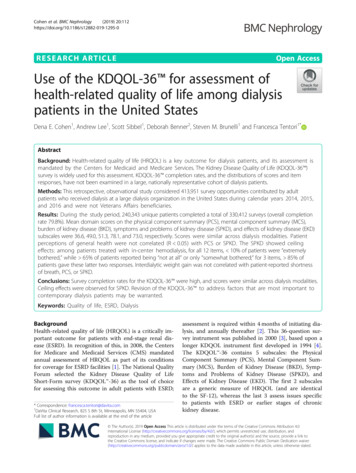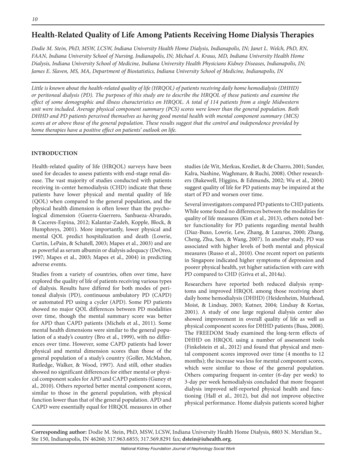
Transcription
Cohen et al. BMC Nephrology(2019) EARCH ARTICLEOpen AccessUse of the KDQOL-36 for assessment ofhealth-related quality of life among dialysispatients in the United StatesDena E. Cohen1, Andrew Lee1, Scott Sibbel1, Deborah Benner2, Steven M. Brunelli1 and Francesca Tentori1*AbstractBackground: Health-related quality of life (HRQOL) is a key outcome for dialysis patients, and its assessment ismandated by the Centers for Medicaid and Medicare Services. The Kidney Disease Quality of Life (KDQOL-36 )survey is widely used for this assessment. KDQOL-36 completion rates, and the distributions of scores and itemresponses, have not been examined in a large, nationally representative cohort of dialysis patients.Methods: This retrospective, observational study considered 413,951 survey opportunities contributed by adultpatients who received dialysis at a large dialysis organization in the United States during calendar years 2014, 2015,and 2016 and were not Veterans Affairs beneficiaries.Results: During the study period, 240,343 unique patients completed a total of 330,412 surveys (overall completionrate 79.8%). Mean domain scores on the physical component summary (PCS), mental component summary (MCS),burden of kidney disease (BKD), symptoms and problems of kidney disease (SPKD), and effects of kidney disease (EKD)subscales were 36.6, 49.0, 51.3, 78.1, and 73.0, respectively. Scores were similar across dialysis modalities. Patientperceptions of general health were not correlated (R 0.05) with PCS or SPKD. The SPKD showed ceilingeffects: among patients treated with in-center hemodialysis, for all 12 items, 10% of patients were “extremelybothered,” while 65% of patients reported being “not at all” or only “somewhat bothered;” for 3 items, 85% ofpatients gave these latter two responses. Interdialytic weight gain was not correlated with patient-reported shortnessof breath, PCS, or SPKD.Conclusions: Survey completion rates for the KDQOL-36 were high, and scores were similar across dialysis modalities.Ceiling effects were observed for SPKD. Revision of the KDQOL-36 to address factors that are most important tocontemporary dialysis patients may be warranted.Keywords: Quality of life, ESRD, DialysisBackgroundHealth-related quality of life (HRQOL) is a critically important outcome for patients with end-stage renal disease (ESRD). In recognition of this, in 2008, the Centersfor Medicare and Medicaid Services (CMS) mandatedannual assessment of HRQOL as part of its conditionsfor coverage for ESRD facilities [1]. The National QualityForum selected the Kidney Disease Quality of LifeShort-Form survey (KDQOL -36) as the tool of choicefor assessing this outcome in adult patients with ESRD;* Correspondence: francesca.tentori@davita.com1DaVita Clinical Research, 825 S 8th St, Minneapolis, MN 55404, USAFull list of author information is available at the end of the articleassessment is required within 4 months of initiating dialysis, and annually thereafter [2]. This 36-question survey instrument was published in 2000 [3], based upon alonger KDQOL instrument first developed in 1994 [4].The KDQOL -36 contains 5 subscales: the PhysicalComponent Summary (PCS), Mental Component Summary (MCS), Burden of Kidney Disease (BKD), Symptoms and Problems of Kidney Disease (SPKD), andEffects of Kidney Disease (EKD). The first 2 subscalesare a generic measure of HRQOL (and are identicalto the SF-12), whereas the last 3 assess issues specificto patients with ESRD or earlier stages of chronickidney disease. The Author(s). 2019 Open Access This article is distributed under the terms of the Creative Commons Attribution 4.0International License (http://creativecommons.org/licenses/by/4.0/), which permits unrestricted use, distribution, andreproduction in any medium, provided you give appropriate credit to the original author(s) and the source, provide a link tothe Creative Commons license, and indicate if changes were made. Th
Background: Health-related quality of life (HRQOL) is a key outcome for dialysis patients, and its assessment is mandated by the Centers for Medicaid and Medicare Services. The Kidney Disease Quality of Life (KDQOL-36 ) survey is widely used for this assessment. KDQOL-36 completion rates, and the distributions of scores and item










